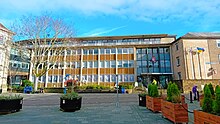Shire Hall, Warwick
| Shire Hall, Warwick | |
|---|---|
 The Shire Hall | |
| Location | Warwick, Warwickshire |
| Coordinates | 52°16′58″N 1°35′21″W / 52.2829°N 1.5891°W |
| Built | 1758 |
| Architect | Sanderson Miller |
Listed Building – Grade I | |
| Designated | 10 January 1953 |
| Reference no. | 1184979 |
Shire Hall is a building complex located in Northgate Street in Warwick, England. It is the main office and the meeting place of Warwickshire County Council. It comprises both the original Shire Hall of 1758 and the more recent adjoining county council offices, both of which are Grade I listed buildings.[1][2]
History
[edit]The first hall
[edit]Although Warwick was founded much earlier, it was not incorporated as a borough until 1545[3] and it was only in 1576 that justice became a borough matter rather than that of the earls.[4] Little is known about the first hall built on the site following this declaration except that £1,161 was levied for repairs and alterations (and the erection of a gaol next door) in May 1674 to be raised by taxes.[4] Work was undertaken by William Hurlbert who had previously erected the town's Market Hall and refurbished Warwick Castle.[5] Due to the fact that it was a sturdy brick-built structure the hall survived the Great Fire of Warwick on 5 September 1694 which destroyed all the surrounding town centre buildings.[6]
The current building
[edit]The original sections of the existing building, which were designed by Sanderson Miller, were constructed by local brothers William and David Hiorn[7] between 1753 and 1758.[8] The design involved a symmetrical main frontage of nine bays facing onto Northgate Street; the central section of three bays featured a round headed doorway flanked by Corinthian order columns supporting a frieze and a pediment containing the county council coat of arms.[1] The principal rooms included a Grand Jury Room on the first floor and the courtrooms on the ground floor.[1]
The building was originally used as a facility for dispensing justice but, following the implementation of the Local Government Act 1888, which established county councils in every county, it also became the meeting place of Warwickshire County Council.[9]


The first major extension of the complex beyond the traditional hall and court rooms took place in 1932. Massively increasing its size the complex spread northward, incorporating the frontage of the old gaol, towards the former barracks, onto the site where the Militia Hall had once stood.[10]

The building was brought up to its current size by construction of a new council chamber and further offices in 1958 and a final expansion in 1966, which included a new frontage and main public entrance for the complex facing Market Place. The latter two developments are classic examples of Brutalist architecture.[11][2] The Queen Elizabeth The Queen Mother officially opened the extension on 3 November 1966.[12]
Included in these alterations were the relocation of the Warwickshire County Emergency Centre, effectively a bunker allowing emergency council business to continue during wartime or terrorist attacks.[13] There are currently two man-made ponds located in the complex, one in the 1930s courtyard and another outside the 1966 section, with metallic sculptures of a heron and fishes added in 2000.[14] The crown and county courts moved to the new Warwickshire Justice Centre in Leamington Spa in 2010.[15]
The television series Father Brown was filmed in and around the Hall in 2014.[16]
In 2024, auction consultant Adam Busiakiewicz collaborated with historian Aaron Manning after identifying a portrait of Henry VIII, commissioned by tapestry maker, Ralph Sheldon (1537–1613). The portrait had originally been listed as missing, yet was hanging unknowingly in the shire hall and was identified as the missing portrait, after a photograph of it appeared on X.[17]
References
[edit]- ^ a b c Historic England. "Old Shire Hall and Law Courts, Warwick (1184979)". National Heritage List for England. Retrieved 13 August 2019.
- ^ a b Historic England. "Warwickshire County Council offices and former gaol (Grade I) (1364827)". National Heritage List for England. Retrieved 24 February 2024.
- ^ Slater, Terry: A History of Warwickshire. Philmore, 1981
- ^ a b Wood, Anthony C: Shire Hall, Warwick, page 3. Warwickshire Local History Society, 1983
- ^ The Shire Hall Before 1675, pages 53-54. Warwickshire County Record Office, 1946
- ^ Cluley, Christine M: Northgate Street, page 15. Riley, Dunn & Wilson Ltd, 2006
- ^ Pevsner, Nikolaus: Warwickshire, page 41. Yale University Press, 1981
- ^ Girouard, Mark: The English Town: A History of Urban Life, page 52. Yale University Press, 1995
- ^ "Local Government Act 1888". Legislation.gov.uk. Retrieved 17 August 2019.
- ^ Cluley, Christine M: Northgate Street, page 44. Riley, Dunn & Wilson Ltd, 2006
- ^ "Shire Hall, Warwick: A Conservation Statement" (PDF). Warwickshire County Council. Retrieved 15 August 2019.
- ^ "Shire Hall, Warwick: A Conservation Statement" (PDF). Warwickshire County Council. p. 252. Retrieved 24 October 2020.
- ^ "Warwick County Emergency Centre". Subterranea Britannica. Retrieved 15 August 2019.
- ^ Author Unknown: Artist wades in with inspiration. Coventry Evening Telegraph, July 21, 2000
- ^ "Warwick Crown Court final sitting marks end of an era". Coventry Evening Telegraph. 1 December 2010. Retrieved 17 August 2019.
- ^ "The Court Room of Shire Hall, Warwick can be seen in "The Grim Reaper"". IMDB. Retrieved 15 August 2019.
- ^ "Missing Henry VIII portrait found after random X post". BBC News. Retrieved 30 July 2024.

